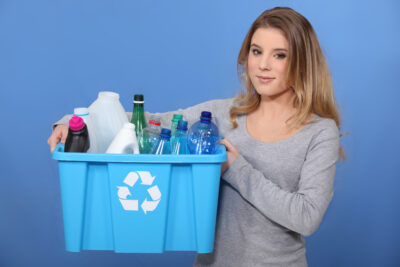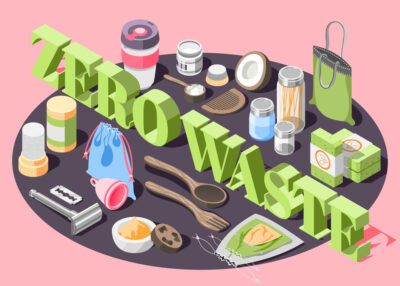Landfills: Every town and city has them. They are malodorous craters of smoking garbage and smoldering trash. In our previous article, we committed to bringing readers more than news about waste management. We promised to also explore the ways our society and industry can create a cleaner, greener, and leaner world. Likewise, we explained our ambitious hopes for a circular economy. The circular economy would eventually annihilate waste. Now, for this week’s topic, let’s see what part landfills play in that effort.
Landfills and Waste: A Guided Tour

Save the Landfills By Properly Recycling.
We must begin our tour with a few basic definitions. No matter what the size of their city, people whose homes are clustered together always generate trash. In the waste management business, we call this type of trash “Municipal waste.”
It is “a combination of all the city’s solid and semisolid waste.” Thus, this contains “household or domestic waste. However, it can also contain commercial and industrial waste…” The exception to this general definition is that the “municipal waste does not include hazardous waste…”
As you might have guessed, hazardous waste is generated by “industrial practices that cause a threat to human or environmental health…)” Thus, we do not consider industrial hazardous waste as municipal waste.” (We are certain we will be covering industrial hazardous waste in another blog. It is normally separated from municipal waste. And it comes with its own specific set of environmental rules and regulations.)
Landfills: Our Journey through Many Categories of Municipal Waste
1. Solid and Semi-solid Wastes:
Thus our first category of waste in the mountainous landscape of trash we observe at the city landfill is solid and semi-solid waste. We also designate it in a general way as household and commercial in origin.
2. Recyclable Materials:
Secondly, within this vast crater, we see mounds and stacks of recyclable materials in various stages of breakage. We can tour through tons of paper and pick our way through many non-biodegradable items. Beware of Glass, lots of plastic bottles, chunks of metal, and, of course, many other types of plastic goods.
3. Inert Waste:

Manufacturers Can Help. Go to “0” With Better Design and Less Packaging.
Moving on with our little excursion. We note evidence of a third type of waste. “Inert waste is the third category of municipal waste. “When discussed with municipal waste, inert materials are those that are not necessarily toxic to all species but can be harmful or toxic to humans.”
Therefore, experts designate construction and demolition waste in this third category of municipal waste, known as inert waste. Walk carefully around chunks of concrete and slippery hills of sand, tiles, and broken ceramics. This type of waste is not chemically nor biologically active.
It does not decompose. Or if it does, it is at a very slow rate. Within this designation, we even see tons of bricks. People could have re-claimed, re-sold, or re-used. But here they lie.
Experts at Smartwaste tell us that creating a single brick requires the same energy as brewing 2 pints of beer. Likewise, they say we are throwing away two million bricks per year.
And More Types of Municipal Waste
If we were really walking through this unfriendly area, we might next encounter stacks of waste that seem to defy categorizing.
4. Composite Waste
Just as the name of this fourth category of municipal waste implies, composite waste is made up of items that “are composed of more than one substance. On our imaginary walk through a landfill, we might see broken tricycles, old yard decorations, and torn clothing trimmed with metal or plastic buttons.
5. Household Hazardous Waste

Landfills are Reminders of Needed Changes And How We Behave As Custodians of the Earth.
Have you ever wondered what happened to that old paint, battery, or light bulb you threw away? “Household hazardous waste is the final category of municipal waste.” We also see “containers from fertilizer and pesticide.
Additionally, there is e-waste like old computers, printers, and cellular phones.” We are proud to note that in some cities, the governments are giving residents new options for disposing of this type of waste.
So, How Much Municipal Waste Are We Building Up?
We knew even casual readers could picture the forbidding environment of our above landfill tour. And they would wonder how many mountains of trash urban populations were sculpting and how fast they were creating it.
- In 2016, the urban population generated 2.01 billion tons of solid waste…
- That means each person contributed approximately 0.74 kg/day.
- The future looks worse, due to urbanization. Experts think “the annual generation of wastes is expected to increase by 70% from 2016 to 2050. They believe “Waste generation is expected to increase from 2.01 billion tons in 2016 to 3.04 billion tons in 2050.”
- Likewise, “the average American tosses 4.4 pounds of trash every single day.
It may not seem all that astonishing on the surface. However, with 323.7 million people living in the United States, that is roughly 728,000 tons of daily garbage. That’s enough to fill 63,000 garbage trucks.
How Long Can Landfills Rescue Us?
The truth is, landfills are limited entities. Although some disagree, there are many experts stating that the 2,000 active landfills in the US are approaching “full.” Apparently, we can only recycle 34.6 percent of our trash.
Additionally, we burn some of it for energy and then, stash the rest of it in our landfills. Previously we exported about 1/6 of our trash to China. However, as of 2018, the Chinese government decided to ban many of the plastics that are difficult to recycle. So, we lost that avenue. (And that’s another story.)
Waste and the Circular Economy

Caring About Our Environment Can Help Create a New and Greener Earth.
If we remain on this course, we could lose our landfills within 18 years. Some cities believe they know the answer. They are currently endorsing the idea of “zero waste.” According to the periodical, Global Citizen, “Zero waste itself means reduced waste generation.
And the 100% diversion of the remainder of waste from landfills to productive uses via materials reuse, recycling, repair, and composting.
Zero waste products should also have minimal negative environmental impacts over their lifecycles.” Thus, if citizens, government, and manufacturers create and consume more waste-conscious products, such cities could achieve a circular economy and re-brace a flailing economy. In President Biden’s words, they could “Build back better.”
In the future, we hope to see improved waste conditions like decreased plastic, less packaging waste, and food waste. However, until Zero waste becomes popularly embraced, we believe waste management is the answer. We’re here to help with the perfect expertise and equipment.






